Every year, prospective students and their families attend hundreds of open days at colleges and universities around the world. These events are more than just campus tours and presentations. They’re often the first real opportunity for students to picture themselves as part of your community. With so many options available, the challenge for institutions is clear: how do you create an open day that not only informs but also inspires?
While the essentials, like academic info sessions, tours, and welcome talks, set the foundation, the schools that stand out go further. They design experiences that feel memorable, personal, and true to their identity. With the right mix of creativity and strategy, your open day can shift from being just another stop on a student’s list to the moment they decide your institution is the right fit.
In this post, we’ll share 10 practical strategies to elevate your open days, whether you’re planning in-person events, virtual formats, or a blend of both. Drawing on real-world examples, including some from HEM’s own portfolio, we’ll explore how you can highlight what makes your institution unique, harness technology, and add thoughtful personal touches that resonate long after the event ends.
What Is an Open Day?
An open day is an event hosted by a college or university to give prospective students and their families the chance to experience the campus, meet faculty and staff, and learn more about academic programs and student life. Unlike brochures or websites, open days provide a first-hand look at the atmosphere of the institution. They typically include tours of facilities, information sessions, and opportunities to speak with current students and alumni. For many students, an open day is the key moment when they decide whether a school feels like the right fit for their academic and personal goals.
In the same vein, what are Application Days at universities? Application days are special events hosted by universities to help prospective students complete their applications on-site. These events often provide access to admissions staff who can guide applicants through the application process, answer questions about requirements, and sometimes even waive application fees.
In many cases, students may receive an admission decision more quickly if they apply during these events, making application days both supportive and efficient for applicants.
1. Showcase What Makes Your School Unique
Every institution has a defining strength, whether that’s a standout program, a strong industry network, or a vibrant campus culture. Open days work best when they put that strength front and center.
- Build around your USP: If partnerships are key, invite industry reps to host networking booths or demos. If location is a highlight, include guided tours of nearby attractions. For research-driven schools, showcase labs or projects with real impact.
- Spotlight distinctive opportunities: Feature sessions on co-op programs, study abroad, or unique facilities like observatories or art galleries.
Example: Royal Roads University: This university played to its innovative reputation with a campaign called “Future View.” Instead of relying on traditional brochures, Royal Roads launched live virtual tours of its campus and classes using GoPro cameras and Google Glass. In other words, prospects could experience campus through a student’s eyes in real time. As part of the campaign, Royal Roads representatives strapped on GoPros and Google Glass to stream lectures, walking tours, and Q&As, giving would-be students a first-hand look at life at RRU.

Source: Times Colonist
2. Offer Interactive and Hands-on Experiences
Static presentations rarely capture the imagination. What sticks are experiences where prospects get to take part, experiment, and play an active role. Today’s students, especially Gen Z, respond best when an open day feels like something they can do, not just watch.
- Classroom-style engagement: Replace long lectures with sample classes, workshops, or lab experiments where visitors actively participate, such as robotics builds or art jam sessions.
- Campus showcase zones: Let departments display projects in interactive formats, flight simulators, artifact handling, or student performances.
- Clubs and student life: Involve student groups with mini debates, telescope viewings, or sustainability scavenger hunts.
- Virtual attendees: Use polls, VR tours, or guided avatars to replicate hands-on engagement online.
Example: The College of ACES at NMSU turned its open house into a family-friendly interactive fair. Visitors of all ages could roam through live animal exhibits, tour science labs and museums, and try their hand at various learning games and demonstrations at each stop. From petting zoo stations with the university’s farm animals to interactive science experiments, the event engaged guests on multiple levels.
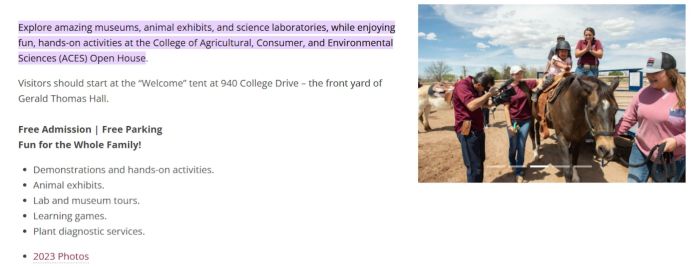
Source: New Mexico State University
3. Empower Your Student Ambassadors as Guides
Your current students are among the most persuasive voices you can showcase on open day. While visitors expect polished messaging from admissions staff, what they really value are honest, relatable insights from peers who have lived the experience. Student ambassadors should therefore be central to the day, whether in person or online, acting as welcoming guides, storytellers, and role models.
Train them with talking points, but give them freedom to share their journeys authentically, from why they chose your school to how they’ve navigated challenges. Their warmth and candor create a sense of trust that brochures and presentations can’t replicate.
Example: University of Central Lancashire (UK): At UCLan’s open days, current students act as official ambassadors, easily spotted in their special red UCLan hoodies. These student ambassadors are stationed at campus entrances to give a warm welcome and directions, they lead campus and accommodation tours, and they hang around after info sessions to chat. Most importantly, they share authentic insights about their courses and social life – the kind of candid student-to-student advice that visitors crave. Attendees are encouraged to approach them with any question, no matter how trivial, making the whole experience feel peer-guided and relatable.
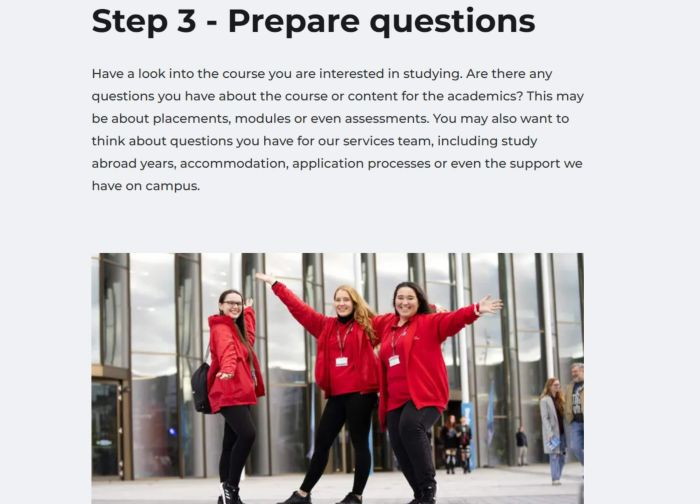
Source: University of Central Lancashire
4. Involve Successful Alumni for Real-World Perspective
Current students show the “here and now” of campus life, but alumni networks embody the long-term value of your institution. Featuring graduates in your open day event gives prospects and their parents confidence that an education with you leads to meaningful outcomes.
Alumni panels, guest talks, or casual meet-and-greet stations can showcase diverse career paths, from industry and entrepreneurship to research and community impact. You might also pair alumni with specific program sessions. Imagine an engineering graduate now at a leading tech firm sharing how campus experiences prepared them for success. Even an “alumni corner” for informal chats helps visitors picture their own future through authentic stories.
Example: The University of Exeter organized a special alumni networking event in Ho Chi Minh City for offer-holders (admitted prospective students) and local alumni. This “Alumni and Offer-Holder” gathering (27 Feb 2023) featured an alumni panel sharing personal stories about studying at Exeter and their career achievements since graduation. Prospective students and their parents were invited to network informally with these alumni and university staff over a reception.
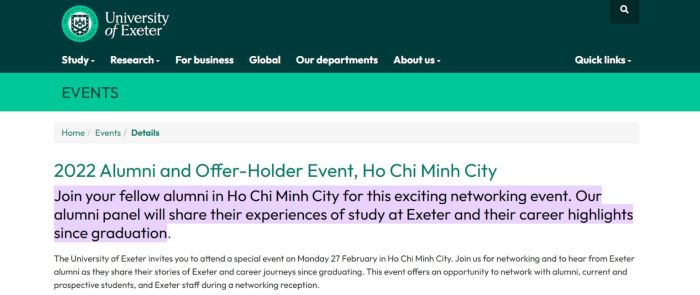
Source: University of Exeter
5. Focus On Parents’ Needs and Questions
Parents and guardians often play a decisive role in a student’s choice, so winning them over is just as important as impressing prospects. A strong open day provides dedicated spaces and sessions tailored to their concerns.
Consider running parent-specific info sessions while students explore elsewhere. These can cover housing, safety, tuition, financial aid, support services, and graduate outcomes, offering direct access to staff from each area. Comfortable lounges, refreshments, and a “Parent HQ” make them feel welcome and valued throughout the day. Printed or digital materials should also speak directly to their perspective, highlighting career outcomes, security measures, and student support systems.
Example: At Cardiff University’s open day, for instance, they held a dedicated session titled “A Parents’ Guide to Higher Education,” where staff walked parents through supporting their child in the application process and beyond. Parents were invited to put their questions to a panel of university experts in finance, student support, and accommodation – essentially a frank Q&A just for them. The topics ranged from tuition fees and scholarship opportunities to the quality of campus facilities. This gave parents a chance to voice any worries in a forum designed for them, separate from their teens.
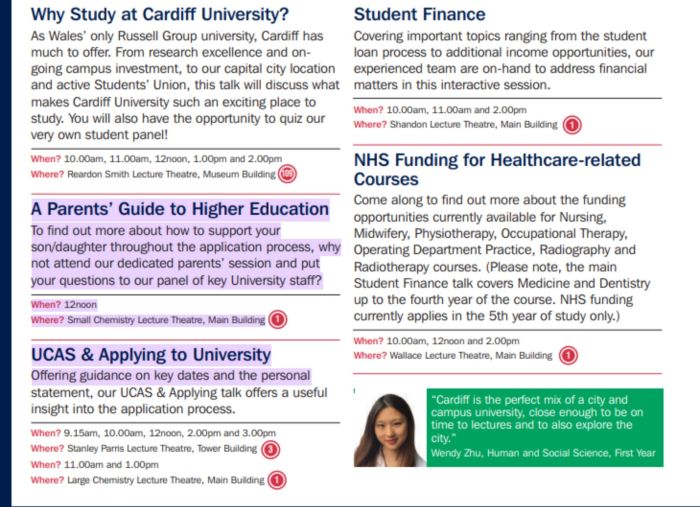
Source: Cardiff University
6. Personalize the Open Day Experience for Visitors
Students don’t all want the same thing from university open days, so personalization can make your event feel far more engaging. Use registration data to create tailored itineraries that reflect interests like intended major, extracurriculars, or career goals. Even simple touches, such as personalized name badges with a program of interest, help staff and ambassadors connect conversations to what matters most for each visitor.
Flexibility is also key. Offer a “choose your own adventure” approach where attendees pick sessions that align with their priorities, whether that’s a lab tour, a faculty panel, or a sports center visit. Train ambassadors to personalize on the fly, asking about interests and adjusting tours or recommendations accordingly.
Example: University of Cincinnati (USA): UC has embraced personalization in a big way. Their Open House events are described as “build your own schedule” experiences where each family creates a custom itinerary for the day. Upon registering for UC’s “Bearcat Open House,” students are prompted to select which academic presentations, campus tours, and special topics interest them. On the day, there isn’t a rigid tour everybody follows; instead, visitors might have a list like: 10:00 AM College of Engineering tour; 11:15 Residence hall open rooms; 1:00 PM Financial Aid Q&A; 2:00 PM Meet the Gaming Club, etc., based on what they choose.
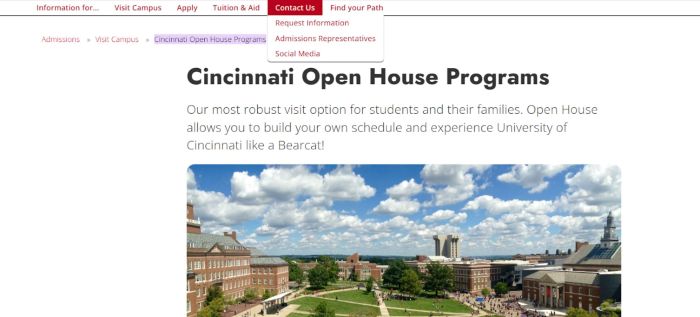
Source: University of Cincinnati
7. Embrace Virtual and Hybrid Open Days to Expand Your Reach
What is a virtual open day? A virtual open day is an online event where prospective students and their families can explore a university without visiting campus in person. Typically hosted on a digital platform, it may include live webinars with faculty, virtual campus tours, student Q&A panels, and one-on-one chats with admissions staff. The goal is to replicate the open day experience digitally, giving participants access to information, interaction, and a feel for campus life, no matter where they are in the world.
Virtual and hybrid open days have become a staple of higher education recruitment, offering accessibility and reach that in-person events alone can’t match. A dedicated virtual event, complete with faculty webinars, student panels, and one-on-one admissions chats, can engage global audiences who might not have the time or resources to travel. Virtual campus tours, whether self-guided or live-streamed, keep your school “open” year-round and give prospects a chance to explore at their own pace.
Hybrid formats add another layer of inclusivity. You might livestream your keynote sessions, run interactive live chats for online viewers, or capture campus highlights to share on demand afterward. Interactive elements like polls, breakout sessions, and virtual “booths” ensure remote participants remain engaged rather than passive viewers.
Example: Brock University (Canada): Brock University has been an early adopter of immersive virtual open day experiences. One innovative approach they took was building an interactive online open house in a 3D virtual environment. Using a platform similar to a retro video game interface, Brock recreated key parts of its campus digitally and let prospective students log in as avatars to explore. When prospects entered this virtual campus, a simulated student guide (an avatar controlled by a Brock student or staff) would greet them and offer to lead a tour. Visitors could navigate their avatar through hallways, into classrooms and labs, and even chat when they “bumped into” other avatars representing faculty or current students.
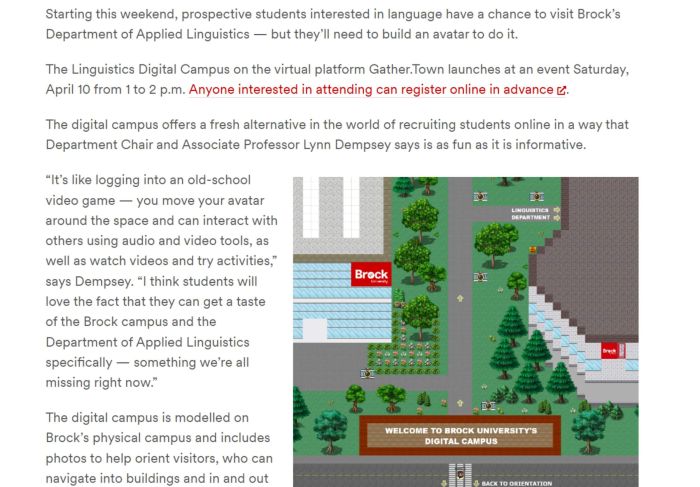
Source: Brock University
8. Harness Social Media for Pre-Event Buzz and Post-Event Engagement
A strong social media strategy can turn your open day from a single event into a shared experience that builds excitement before, during, and after. Start with a dedicated event hashtag and use it across all promotions, encouraging attendees to post their questions and experiences.
During the event, showcase live content: Instagram Stories, TikTok snippets, or a feed of hashtagged posts, to engage both in-person and virtual audiences. Afterward, curate user-generated content into a recap post or gallery, and follow up with a thank-you message paired with a clear call-to-action, such as “Book a chat with a student ambassador” or “Apply now.”
Example: Lancaster University (UK): Lancaster provides a masterclass in using student-driven social media to boost recruitment events. In 2020, with in-person events off the table, Lancaster University asked its student ambassadors to create a series of fun TikTok videos as ads to generate excitement for its online open days. Instead of polished commercials, these were authentic clips following TikTok trends. Think students doing campus tours set to music, quick dorm room tours, or tongue-in-cheek “day in the life” sketches. The result? The campaign blew past expectations: over 10 million impressions and 90,000+ clicks through to Lancaster’s open day info page.
Source TikTok
9. Add Memorable Touches and Fun Surprises
Sometimes it’s the little extras that transform an open day from ordinary to unforgettable. First impressions matter, so think about how your visitors are welcomed the moment they arrive. Clear signage, friendly greeters, and a thoughtful welcome pack with a campus map, schedule, and small pieces of branded swag can immediately put families at ease.
Fun moments sprinkled throughout the day also make a difference. A student band playing in the quad, a scavenger hunt through key campus spots, or a quirky photo booth at the student life fair can lighten the mood and help prospects associate your institution with energy and creativity.
Example: Temple College (USA): This community college in Texas put a delightful twist on their open house by setting up a photo booth with their mascot, a leopard nicknamed “TC Leopard.” Students and families could pose with the costumed mascot and snap fun pictures – a perfect keepsake to take home and share on social media. Temple College even turned it into a mini-contest where participants could win small prizes for posting their mascot photos. The result was a lot of laughter, and every family left with a tangible memory (a photo print or a digital pic) of the day.
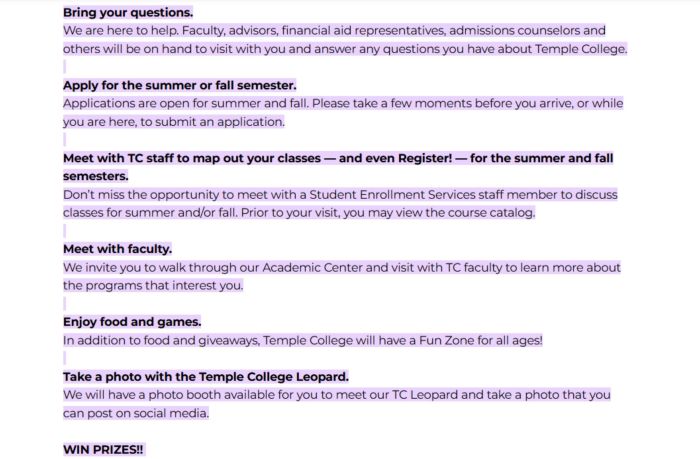
Source: Temple College
These kinds of small but meaningful touches linger in memory. Long after presentations fade, visitors will remember how welcome, entertained, and cared for they felt. That emotional connection can tip the scales when it comes time for students to make their final choice.
10. Follow Up and Continue the Conversation
An open day doesn’t end when the last tour wraps up. In fact, some of the most important work happens afterward. A thoughtful follow-up plan not only shows prospective students and parents that you value their visit, but also keeps the momentum going as they move closer to making a decision. Too many institutions stop at a generic “thank you for coming.” By going a step further, you stand out.
Send a prompt, personalized thank-you. Ideally, within 24-48 hours, shoot attendees an email (or even a text message, if they opted in). Make it more than just “Thanks for coming.” Use merge fields to include the student’s name and perhaps one detail from their registration or what they did.
For example: “Hi Alex, thank you for visiting our Open Day on Saturday! We hope you enjoyed the Biology lab tour and the sample lecture in psychology.” This level of detail shows that you noticed their presence. Then, include helpful next steps: links to apply, to book a one-on-one meeting, or to a video recap of the event.
Example: Morton College (USA): This college nailed the follow-up game. Right after their open house, Morton College rolled out a one-two punch of follow-ups. They sent out personal thank-you emails to attendees, and at the same time, they put out a public thank-you on their social media pages. Importantly, it didn’t stop at gratitude – the post also included a next step, reminding students that registration was open for the upcoming semester and providing a link to get started.
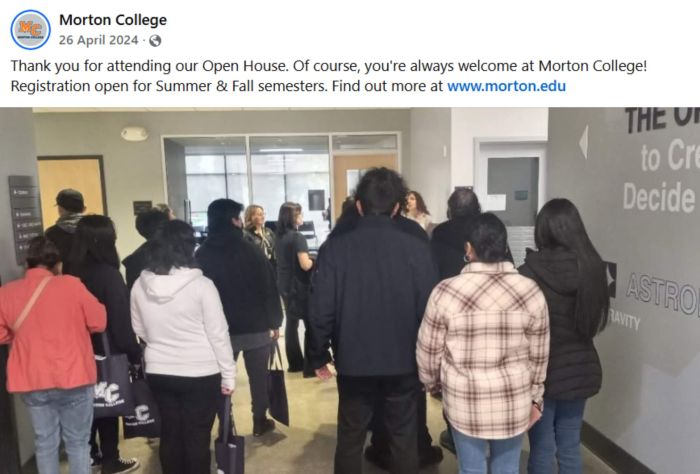
Source: Morton College
Strong follow-up also means nurturing interest over time. Sharing student stories, reminders about upcoming deadlines, or invitations to future events extends the relationship beyond one day. In the end, what sets your open day apart is how well you continue to guide students once they’ve left campus.
From Open Day to Enrollment: Your Next Step
Open days (or open house events) are a cornerstone of student recruitment in higher education. They’re your chance to say, “Here’s who we are, here’s what makes us special, and here’s the community you could join.” By implementing these strategies, from showcasing your unique strengths, creating interactive experiences, and leveraging students/alumni, to embracing virtual formats, social media, personalization, and strong follow-up, you can elevate your open day from a routine tour into an unforgettable event that resonates with attendees long after they’ve gone home.
Remember, the goal isn’t just to convey information, but to make prospective students feel something: excitement about an academic program, a sense of belonging on campus, confidence that your school is the right fit, or the inspiration to take the next step towards enrollment. When you make your open days stand out, you ultimately make your institution stand out in a crowded higher education market.
Planning an exceptional open day does take effort and creativity, but the rewards are enormous. Many students cite campus visits and open days as the moment they “knew” which school was right for them. By following the approaches outlined above, you’ll increase the chances that your event is the one that wins their hearts. Good luck with your next open day event, and have fun making it one to remember!
Frequently Asked Questions
Question: What is an open day?
Answer: An open day is an event hosted by a college or university to give prospective students and their families the chance to experience the campus, meet faculty and staff, and learn more about academic programs and student life.
Question: What are Application Days at universities?
Answer: Application days are special events hosted by universities to help prospective students complete their applications on-site.
Question: What is a virtual open day?
Answer: A virtual open day is an online event where prospective students and their families can explore a university without visiting campus in person. Typically hosted on a digital platform, it may include live webinars with faculty, virtual campus tours, student Q&A panels, and one-on-one chats with admissions staff.







